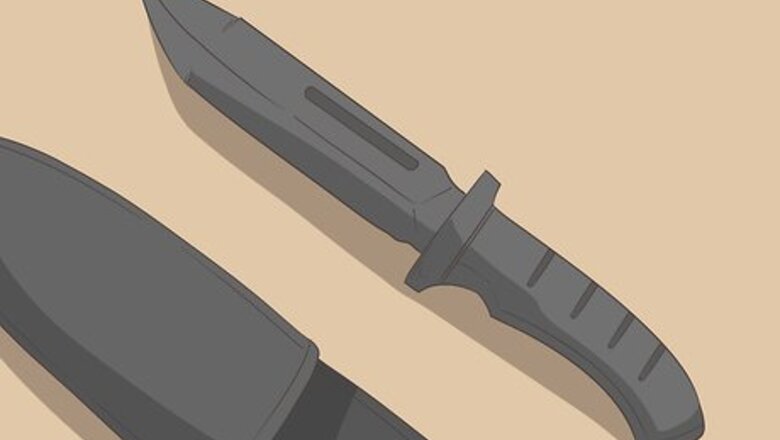
views
Holding the Knife
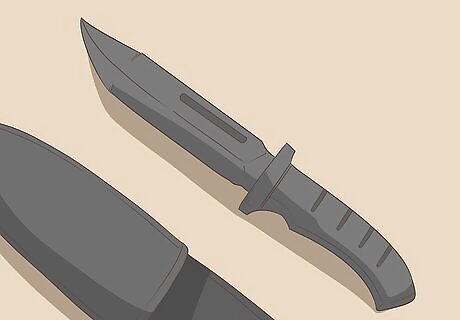
Use a training knife to practice safely. A training knife is sturdy and heavy to simulate the look and feel of a real knife but isn’t sharp so you can safely practice your kali techniques. Choose a training knife to train with so you don’t injure yourself or any training partners you work with. You can find training knives at your local martial arts supply store or by ordering them online. If you don’t have access to a training knife, you can improvise by using sticks or dull butter knives.
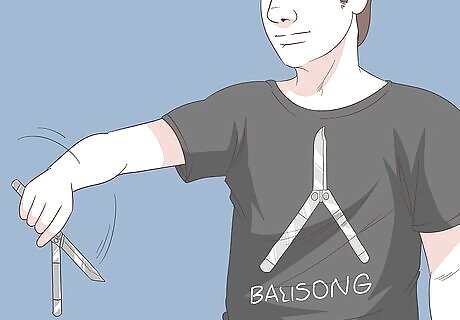
Choose a balisong trainer for a more traditional kali knife. A balisong, also known as a butterfly knife, has 2 handles that conceal the blade and rotate open. Because they’re easy to conceal, they’ve been traditionally used by kali practitioners, so choose a blunt training version if you want to practice with one. Practice opening a balisong, or butterfly knife, to get comfortable before you start training with one. Filipino fighting culture focuses more on edged weapons such as knives and swords, rather than guns. A balisong allows you to conceal a relatively large blade for self-defense.

Grip the handle like you’re holding a hammer for a basic knife hold. A basic forward grip allows you to perform slashes, jabs, and thrusts with your knife. Take a firm grip on the handle of the knife so the blade is pointing up. Wrap your fingers around it like you’re making a fist. Imagine that you’re holding a hammer to help you take a sturdy grip of the knife. If the knife has a single edge, hold it so the edge is facing away from you.
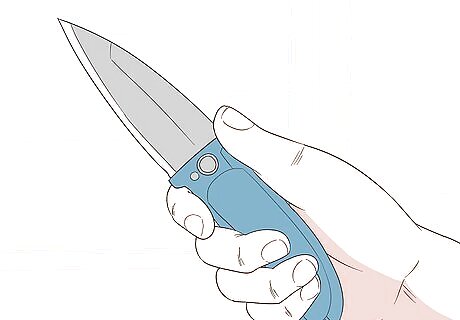
Use a thumb support grip for lightweight knives. Lighter knives or knives that flip open may be pushed back against your hand if you use it to send a slashing or thrusting strike. Take a firm grip on the handle like you’re holding a hammer, then move your thumb so it’s pressed against the backside of the handle to provide more support. You can also use this grip if it feels more comfortable than the hammer grip.
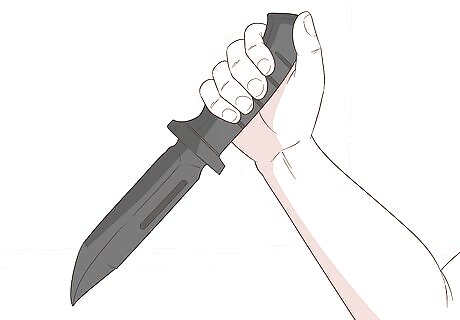
Switch to a reverse grip to train different knife positions. Hold the handle of the knife so the blade is pointing down, like an icepick. Take a firm grip, like a hammer grip, except in reverse, and switch to reverse grips during your training to become proficient in a variety of techniques. Kali practitioners train to be prepared for any situation. For instance, if you quickly grab a knife in a reverse grip position during a self-defense situation, you want to know how to use it. Some practitioners prefer the reverse grip for different strikes such as jabs or downward thrusts.
Learning Basic Knife-Fighting
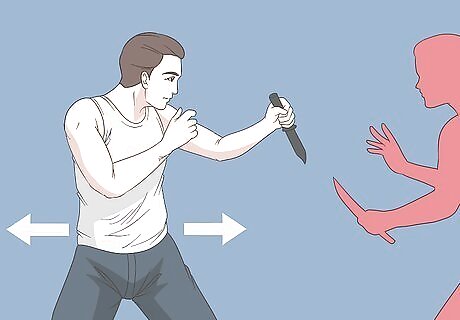
Move at an angle toward or away from your opponent when you strike. When you’re training kali knife techniques, always move at a diagonal angle when you move forward or backward to put yourself out of the direct line of your opponent. If you want to move to the side, move at a 90-degree angle from your opponent so they have to adjust to face you, which can set up strikes. If you’re out of the direct line of your opponent, it’s much more difficult for them to strike you and can set up strikes of your own.

Keep your empty hand close to your chest. While you’re holding your knife with 1 hand, keep your other hand close to your chest so it’s out of the way and you won’t accidentally cut yourself. If it’s helpful, try pressing your hand against your chest to get used to keeping it out of the way as you learn the basics. Even when you’re using a training knife that won’t cut you, it’s always good practice to train like you’re using the real thing to build good habits.
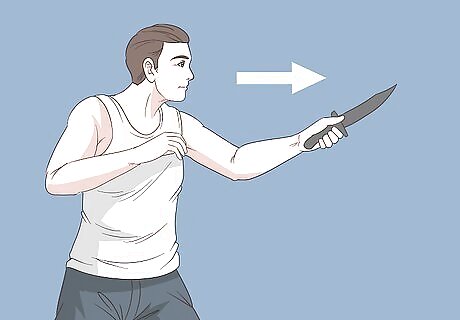
Thrust the tip of the knife forward to deal maximum damage. Point the tip of the knife toward your opponent and extend your arm forward quickly to thrust the knife forward. Return your arm and knife back to the original starting position so you’re prepared to defend or send additional strikes. Avoid leaning or jumping forward so your weight stays centered over your feet and you’re balanced. Don’t leave your arm hanging out there for too long. Keep your thrusts quick and snappy.
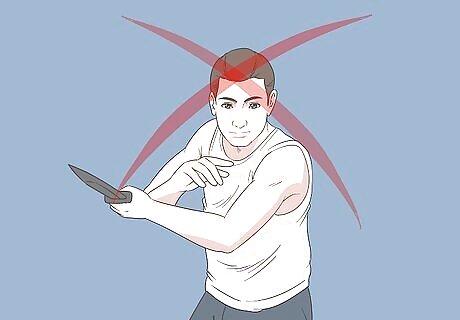
Use an X pattern to practice diagonal forward slashes. Practice making both upward and downward diagonal slashing motions with your knife by moving the blade in an X pattern. Send multiple diagonal slashes and flow through the motions to make your strikes more smooth and fluid. Remember, “slow is smooth, smooth is fast.” As you improve your skill, your movements will become faster. But it’s super important that you get the basics down fluidly and smoothly. Keep a tight grip on the knife so it doesn’t slip out of your hand. When you're fighting with a knife, remember to keep the sharp edge turned toward your opponent—you don't want to strike them with the dull or flat edge.

Slash in a + pattern to train vertical and horizontal strikes. Swing the knife toward your opponent and make a plus sign (+) pattern to send horizontal and vertical slashing strikes. Practice sending the slashes up and down and side to side in both directions to improve your technique from all angles. Combine X and + patterns to flow through multiple slashing angles. Try setting a 2-minute timer and practicing constant slashing motions to build muscle memory.
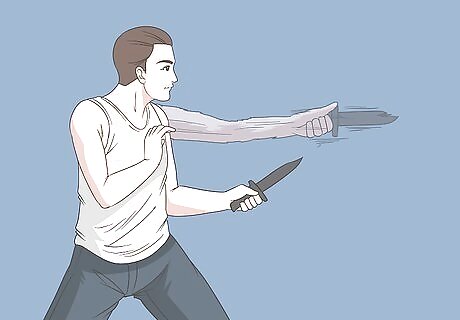
Snap the knife quickly at your opponent to perform a jab. A jab in kali is similar to a jab in boxing and involves a short, snappy punch forward with the knife. Point the tip of the knife toward your opponent and quickly poke the tip at them to send a fast jab before bringing your hand back to the original starting point. A jab is slightly different than a thrust because it’s meant to be faster and less powerful, but aimed at vulnerable spots like the eyes and throat. Thrusts are generally used to target the body. Be careful when you use jabs if you’re training with a partner. Even the blunt tip of a training knife can seriously injury vulnerable places like eyes.

Practice jabs and thrusts with a reverse grip as well. While you’re practicing your basic techniques, be sure to switch to a reverse grip to train different angles and positions. Send thrusts and jabs while holding the knife in a reverse grip position. Downward thrusts can be more powerful from a reverse grip position.

Wave your empty hand at your opponent to parry their attacks. Stop and redirect your opponent’s knife strikes by waving your empty hand at their attacking knife-hand. Scoop your hand like your waving to move their arm so the knife doesn’t cut you. Parrying your opponent’s attacks also sets up counterstrikes you can send with your knife-hand.
Trying Advanced Techniques

Combine multiple techniques to drill complex strikes. Send a jab, then roll the blade downward to slash your opponent. Try an upward diagonal slash then thrust the blade toward your opponent. Play around with multiple strikes and put them together into advanced combinations. Try slowly going through combinations and pick up the speed as you get more comfortable. Don’t worry about mistakes or awkwardness as you try your hand at more advanced techniques. Everyone has to start somewhere! Drills are a great way to build up your speed, and they carry less risk of injury than sparring with an opponent.
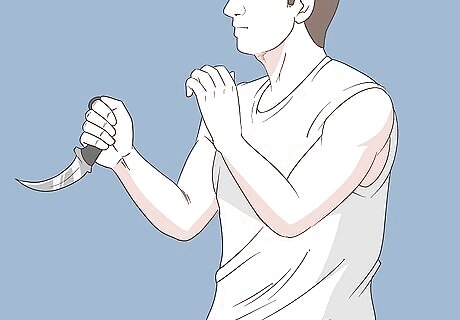
Practice with a karambit for an advanced knife option. A karambit is a curved, claw-like fighting knife from Southeast Asia that is sometimes used by advanced kali practitioners. Insert your index finger into the ring of the knife and hold the handle so the curved blade extends from the bottom of your hand. Hold the knife so the tip is pointed forward so the edge doesn’t cut you. Practice your jabs, slashes, and thrusts with a karambit to get comfortable with it. You can find a karambit at specialty knife stores or by ordering one online.
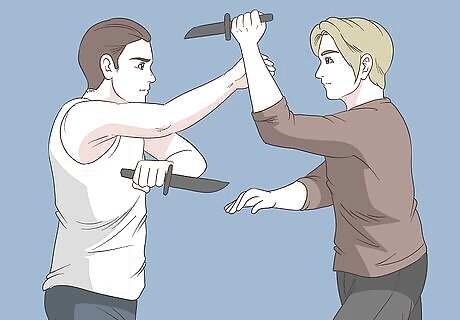
Work with a partner to practice blocks and live strikes. Use a training knife and have your partner use a training knife as well to practice. Send thrusts, jabs, and slashes at your opponent to simulate a real knife fight. Have your partner send strikes at you as well so you can train to block them with your forearms and send counterstrikes. Always be a good partner and send light strikes to avoid injuries. Practice flowing through multiple strikes and blocks to get comfortable with them.
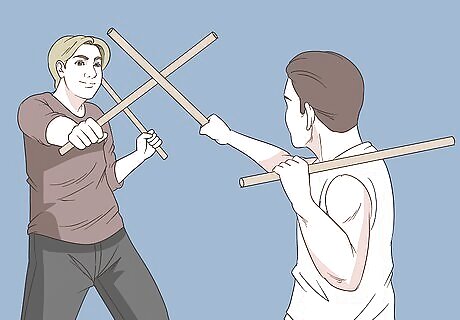
Join an escrima school to learn advanced kali techniques. Escrima, also called arnis, is an umbrella term for Filipino weapons-based martial art, and kali is a part of that. Kali focuses on knives, while escrima uses swords and sticks. Search online for an escrima school in your area that offers kali classes and sign up to train with an expert practitioner who can show you new techniques and make corrections to improve your skill. Kali falls under the umbrella of escrima. You can also try searching for kali instructors in your area and sign up for private training with them.

















Comments
0 comment